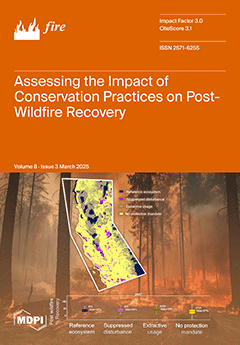Wildfire activity in the western U.S. has highlighted the importance of effective management to address this growing threat. The Lookout Mountain Thinning and Fuels Reduction Study (LMS) is an operational-scale, long-term study of the effects of forest restoration and fuel reduction treatments in ponderosa pine (
Pinus ponderosa Dougl. ex Laws.) and mixed-conifer forests in central Oregon, U.S. The broad objectives of the LMS are to examine the effectiveness and longevity of treatments on wildfire risk and to assess the collateral effects. Treatments include four levels of overstory thinning followed by mastication of the understory vegetation and prescribed burning. Stands were thinned to residual densities of 50, 75, or 100% of the upper management zone (UMZ), which accounts for site differences as reflected by stand density relationships for specific plant communities. A fourth treatment combines the 75 UMZ with small gaps (~0.1 ha) to facilitate regeneration (75 UMZ + Gaps). A fifth treatment comprises an untreated control (UC). We examined the causes and levels of tree mortality that occurred 2–9 years after treatments. A total of 391,292 trees was inventoried, of which 2.3% (9084) died. Higher levels of tree mortality (all causes) occurred on the UC (7.1 ± 1.9%, mean ± SEM) than on the 50 UMZ (0.7 ± 0.1%). Mortality was attributed to several bark beetle species (Coleoptera: Curculionidae) (4002 trees), unknown factors (2682 trees), wind (1958 trees), suppression (327 trees), snow breakage (61 trees), prescribed fire (19 trees), western gall rust (15 trees), cankers (8 trees), mechanical damage (5 trees), dwarf mistletoe (4 trees), and woodborers (3 trees). Among bark beetles, tree mortality was attributed to western pine beetle (
Dendroctonus brevicomis LeConte) (1631 trees), fir engraver (
Scolytus ventralis LeConte) (1580 trees), mountain pine beetle (
Dendroctonus ponderosae Hopkins) (526 trees), engraver beetles (
Ips spp.) (169 trees), hemlock engraver (
Scolytus tsugae (Swaine)) (77 trees), and
Pityogenes spp. (19 trees). Higher levels of bark beetle-caused tree mortality occurred on the UC (2.9 ± 0.7%) than on the 50 UMZ (0.3 ± 0.1%) which, in general, was the relationship observed for individual bark beetle species. Higher levels of tree mortality were attributed to wind on the 100 UMZ (1.0 ± 0.2%) and UC (1.2 ± 1.5%) than on the 50 UMZ (0.2 ± 0.02%) and 75 UMZ (0.4 ± 0.1%). Higher levels of tree mortality were attributed to suppression on the UC (0.5 ± 0.3%) than on the 50 UMZ (0.003 ± 0.002%) and 75 UMZ + Gaps (0.0 ± 0.0%). Significant positive correlations were observed between measures of stand density and levels of tree mortality for most causal agents. Tree size (diameter at 1.37 m) frequently had a significant effect on tree mortality, but relationships varied by causal agent. The forest restoration and fuels reduction treatments implemented on the LMS increased resistance to multiple disturbances. The implications of these and other results to the management of fire-adapted forests are discussed.
Full article





